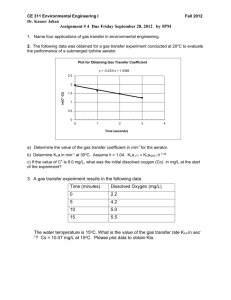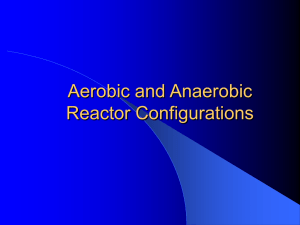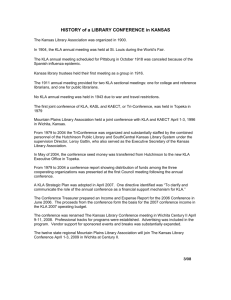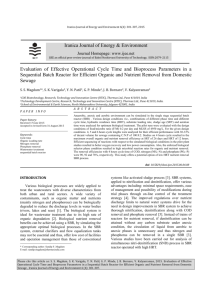instructions to authors for the preparation of manuscripts
advertisement
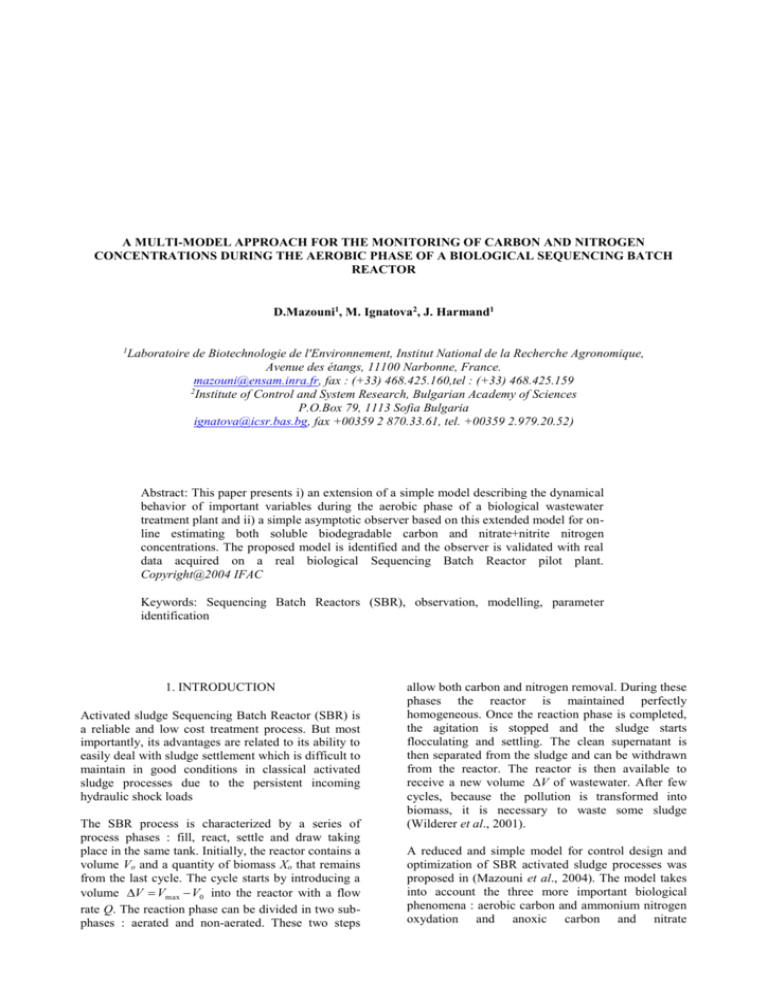
A MULTI-MODEL APPROACH FOR THE MONITORING OF CARBON AND NITROGEN CONCENTRATIONS DURING THE AEROBIC PHASE OF A BIOLOGICAL SEQUENCING BATCH REACTOR D.Mazouni1, M. Ignatova2, J. Harmand1 Laboratoire de Biotechnologie de l'Environnement, Institut National de la Recherche Agronomique, Avenue des étangs, 11100 Narbonne, France. mazouni@ensam.inra.fr, fax : (+33) 468.425.160,tel : (+33) 468.425.159 2 Institute of Control and System Research, Bulgarian Academy of Sciences P.O.Box 79, 1113 Sofia Bulgaria ignatova@icsr.bas.bg, fax +00359 2 870.33.61, tel. +00359 2.979.20.52) Abstract: This paper presents i) an extension of a simple model describing the dynamical behavior of important variables during the aerobic phase of a biological wastewater treatment plant and ii) a simple asymptotic observer based on this extended model for online estimating both soluble biodegradable carbon and nitrate+nitrite nitrogen concentrations. The proposed model is identified and the observer is validated with real data acquired on a real biological Sequencing Batch Reactor pilot plant. Copyright@2004 IFAC Keywords: Sequencing Batch Reactors (SBR), observation, modelling, parameter identification 1. INTRODUCTION allow both carbon and nitrogen removal. During these phases the reactor is maintained perfectly homogeneous. Once the reaction phase is completed, Activated sludge Sequencing Batch Reactor (SBR) is the agitation is stopped and the sludge starts a reliable and low cost treatment process. But most flocculating and settling. The clean supernatant is importantly, its advantages are related to its ability to then separated from the sludge and can be withdrawn easily deal with sludge settlement which is difficult to from the reactor. The reactor is then available to maintain in good conditions in classical activated receive a new volume V of wastewater. After few sludge processes due to the persistent incoming hydraulic shock loads cycles, because the pollution is transformed into biomass, it is necessary to waste some sludge The SBR process is characterized by a series of (Wilderer et al., 2001). process phases : fill, react, settle and draw taking place in the same tank. Initially, the reactor contains a A reduced and simple model for control design and volume Vo and a quantity of biomass Xo that remains optimization of SBR activated sludge processes was from the last cycle. The cycle starts by introducing a proposed in (Mazouni et al., 2004). The model takes into account the three more important biological volume V Vmax V0 into the reactor with a flow phenomena : aerobic carbon and ammonium nitrogen rate Q. The reaction phase can be divided in two suboxydation and anoxic carbon and nitrate phases : aerated and non-aerated. These two steps 1 denitrification. The proposed model was identified and cross-validated using 15 experiments that were carried out from 05.08.2003 to 15.04.2004 in the Laboratory of Environmental Biotechnology (LBE) INRA Narbonne, France. One of the main difficulties in control design and its practical implementation is the lack of cheap and reliable on-line sensors for the main process variables. To overcome this problem an asymptotic observer of both soluble biodegradable carbon, S1, and nitrate+nitrite nitrogen concentrations, S3 during the aerobic phase is proposed hereafter (Bastin et al 1990). In order to take advantage of the information contained in the dissolved oxygen concentration (which is a cheap and reliable industrial sensor), an extended model including its dynamics is used here instead of the simple model proposed in (Mazouni et al., 2004). Then, the observer is derived on the basis of this extended model. The model parameters are identified and the observer is cross-validated. For this purpose, 6 experiments that were carried out from 27.10.2003 to 12.11.2004 in the LBE are used. More specifically, the experiments are classified in three groups depending of the value of oxygen mass transfer coefficient, KLa. One set of model parameters is identified for each group. Finally, some conclusions and perspectives are drawn 2. MODELLING A schematic view of the process available at the LBE, Narbonne, France, is given in figure 1. 1 2 3 4 volume is added (25 liters). A schematic view of the operating modes is shown in figure 2. Aerobi Fill 0 2 4 Anoxic 10 12 Settle 22 Draw 24 Time [h] Fig.2 SBR cycle phases Because both the carbon and nitrogen are treated, two specific phases are needed : aerobic (presence of oxygen) and anoxic (no oxygen but nitrite and nitrate). During the anoxic phase, the nitrite+nitrate from the last cycle are transformed into gaseous nitrogen. This step is realized by heterotrophic bacteria who also need soluble organic carbon to grow (Hu et al, 2003)( Jeppsson, 1996). When all the nitrite-nitrate has been removed, one can switch to aerobic mode where the ammonium nitrogen will be transformed into nitrite and nitrate while the remaining soluble carbon will be removed. From now, we only concentrate on what happens during the aerobic phase and the following notations are used : X1 : Heterotrophic microorganisms. (mg/l) X2 : Autotrophic microorganisms (mg/l) S1 : Organic carbon. (mg COD /l) S2 : Ammonium nitrogen. (mg N-NH4/l) S3 : Nitrates/Nitrites nitrogen (mg N-NO3/l+ mg NNO2/l) S4: Dissolved oxygen (mg O2/l) The reaction scheme of the aerobic phase is as follows : 5 Input k 1 S1 k 4 S 4 6 7 Out put 1. 2. 3. 4. 5. 6. 7. 8. DO pH O2 gas CO2 gas Sludge level Temperature Redox withdraw valve Fig 1 : SBR pilot plant The tank of the reactor has a cylindrical form. Its dimensions are 50cm and 130cm height with a total volume of 255L. It is equipped with a variable flow rate pump to fill the reactor and a controlled valve to withdraw the effluent and the sludge in excess. Air is used for aeration and mixing. Its flow is controlled by a flow meter. k 2 S 2 k 5 S 4 1 2 X1 X 2 k3S3 (1) This synthetic scheme means that S1 and S2 are degraded by X1 and X2 respectively with the rates and in the presence of S4. In other words, the pollutant S1 serves as a basis for the growth of X1 while S2 is transformed into S3 by X2. Considering the above reaction scheme, we can apply the mass balance principle to determine the state space model of the aerobic phase (Bastin et al 1990): X 1 1 (S1 , S 4 ) X 1 (2) X 2 2 (S1 , S 4 ) X 2 (3) S 1 k11 (S1 , S4 ) X 1 (4) The reactor is operated at an ambient lab temperature of 20°C. Each cycle duration is 24 hours. More specifically, the reaction phases are divided into 2 periods. In each one, half of the total influent daily S 2 k2 2 (S1 , S4 ) X 2 (5) S 3 k3 2 (S1 , S 4 ) X 2 (6) S 4 k4 1 (S1 , S4 ) X 1 k5 2 (S1 , S4 ) X 2 K L a(S4max S4 ) with S 1 S1* 1 1max K S1 S1 S1* 2 2 max S4 ; (8) S2 S4 . K S 2 S2 As can be seen, the specific growth rates in aerobic phase, and , are proportional to the dissolved oxygen concentration, S4, in the reactor instead of the S4 classical expression proposed in (Henze et KO S4 al., 1987). It is essentially because the available experiments were realized with a non-limiting oxygen concentration, S* being the average of residual COD in the reactor (Mazouni et al., 2004). 3. MODEL IDENTIFICATION It was shown in (Mazouni et al, 2004) that the model is very sensitive to the oxygen transfer coefficient KLa. This parameter is itself very sensitive to environmental conditions such as input air flow rate. When operating in real conditions, it is possible to classify the operating conditions into a finite number of classes depending on the input air flow rate. That way, a limited number of set of process parameters can be identified and, depending on the environmental conditions, the user can predict the future behavior of the process in using the specific model associated with the actual operating conditions. In other words, we use a multi-model approach : the process is not described by only one model but by n models, each of them being related to a given range of input air flow rates (a value of KLa). For the parameter identification, the procedure used is the same than the one proposed in (Mazouni et al., 2004). Available experimental data correspond to 6 aerobic SBR cycles where the influent concentrations and the input air flow rate were changed as mentioned in Table 1. Four experiments were performed with an influent concentration of 50 l/min (namely the experiments realized on 27.10.03, 29.10.03, 31.10.03 and 04.11.03). The influent concentration for the experiment No. 06.11.03 is 75 l/min and for experiment No. 12.11.03 is 25 l/min. In the last column in Table 1, the values of oxygen mass transfer coefficients, KLa, that are calculated for each experiment are shown. As can be seen, three types (classes) of experiments could be distinguished, according the value of KLa. The first one consists of four experiments with KLa=18.75; the two others listed in the Table 1 consist of one experiment namely 06.11.03 and 12.11.03 with KLa=23.00 and KLa=9.60 respectively. The experiments No. 27.10.03, 29.10.03, 31.10.03 are used for parameter identification of process model of the group with KLa=18.75. The experiment 04.11.03 is used for cross-validation of this model. The others two groups are presented with an unique experiment for each group. The experiments were carried out in winter periods of the year : three experiments in October, and three in November. Table 1 Influent concentration and air flow rate for each experimental data used for identification Exp. No Air flow (l/min) 27.10.03 50 29.10.03 50 31.10.03 50 04.11.03 50 06.11.03 75 12.11.03 25 Remember that the aerobic model consists of six variables and nine parameters. The parameters max1 and max2 are the maximum specific growth rates of X1 and X2 (Heterotrophic and Autotrophic microorganisms respectively); Ks1 and Ks2 are saturation constants associated with substrates S1 and S2 respectively; k1, k2 and k3 are the yield coefficients for degradation of S1 by X1 and S2 by X2; and for the production of S3 by X2 respectively. The coefficients k4 and k5 are oxygen yield coefficients associated with X1 and X2 respectively while S4max is the maximal value of dissolved oxygen in the liquid medium. COD in NTK in (mg/l) (mg/l) 4318.18 168.00 4772.25 183.68 4476.92 204.40 4836.85 319.20 4235.45 260.4 4945.61 285.60 KLa (h-1) 18.75 18.75 18.75 18.75 23.00 9.60 An optimization algorithm that was proposed in (Mazouni et al., 2004) is applied for model parameter estimation. The optimization criterion is chosen to obtain the minimal error between experimental data and simulated outputs of the system (2)-(8). The results of parameter estimation are shown in Table 2. As can be seen, different sets of parameter values are obtained for each class of experiments depending on the value of KLa. Model parameter values of the group with KLa=18.75 are obtained as medium values of three experiments and cross-validated with the data of the fourth one. The model parameters are shown in the Table 2. Table 2 Estimated parameters for aerobic model Exp. N 27.10.03 29.10.03 31.10.03 model 06.11.03 12.11.03 µ1max 0.014 0.023 0.031 0.023 0.027 0.031 µ2max 0.023 0.016 0.013 0.017 0.012 0.013 KS1 192.7 107.9 112.3 137.6 109.2 98.2 In Figures 3 (a,b,c and d), the model for experiments with KLa=18.75 is cross-validated with data from the experiment No. 04.11.03 (not listed in Table 2). The model parameters are obtained as medium values of KS2 93.3 91.8 101.7 95.6 111.9 101.3 k1 5.81 1.99 2.34 3.38 2.63 4.67 k2 0.55 0.76 0.71 0.67 0.64 0.90 k3 0.25 0.32 0.27 0.28 0.30 0.28 k4 0.35 2.43 2.43 1.74 1.99 1.40 k5 8.96 7.25 7.33 7.85 6.99 6.02 parameters of the other experiments of the same group that are used for model identification. Fig.4. Model parameter cross-validation. (-)model and No 04.11.03 experimental data (*). 4. OBSERVER DERIVATION In the last section, we have derived three models for three different values of input air flow rates. The model parameters have been estimated. It should be noticed that these models could be used to derive observers of diverse classes. However, biological processes exhibit uncertain behaviours and our objective is to design a system able to monitor S1 and S3 from the on-line measurements of S2 and S4 – independently of the reaction kinetics - which, with no doubt, are the terms that are the most affected by uncertainty. The process model (equations (2)-(8)) can be written in a matrix format as follows: K F (9) where S1 S2 S3 S4 X1 X2is the vector of process variables; K is the matrix of yield coefficients; [ is the vector of reaction rates and F is the vector of mass feed rate in the reactor. The model (9) describes the batch aerobic autotrophic growth and consists of two main parts. The first term represents process kinetics and the second one represents the transport dynamics. From now, the process kinetics is only partially known : the reaction rates (X1 and X2) are unknown while the values of the yield coefficients in the matrix K are known. The transport dynamics is known. It consists of oxygen supply by aeration. Introducing the auxiliary variables : k2 Z1 S 2 k S 3 3 k Z S 4 S k5 S 4 1 2 2 k1 k3 (10) allows us to consider the following dynamical submodel : dZ1 dt 0 dZ 2 K a( S max S ) L 4 4 dt (11) Assuming that S2 and S4 are measured on-line and that Z1(0)= Z10 and Z2(0)= Z20 are known, the system (10)(11) can be used to get an on-line estimation of S1 and S3 as : k5 k1 k1 ˆ S1 k k ( Z1 S 2 ) k ( Z 2 S 4 ) 2 4 4 k Sˆ 3 ( Z S ) 3 1 2 k2 Fig. 4. Experimental No 04.11.03 data and estimation of S1 and S2 (12) Notice that equations (12) is not an "observer" (nor even a detector!) since it is necessary to exactly know both Z10 and Z20 to correctly estimate S1 and S3 from the on-line measurements of S2 and S4. Rather it is a tricky way of estimating S1 and S3 without getting any idea of 1 and 2. Fig. 5. Experiment No 06.11.03 data and estimation of S1 and S2 6. RESULTS AND DISCUSSION The multi-model monitoring system for the first group was validated by comparing the observation curves with data of experiment No. 04.11.03. The comparison between the real data and the output of the monitoring system are shown in figures 4. The necessity of determining the initial values of the system (11) can be solved as follows. As explained in the introduction, at the beginning of the aerobic phase, there is no nitrite nor nitrate in the reactor. Thus S3(0)=0. Since S2 is measured, S2(0)=S20 is known. From equation (10), one concludes that Z1(0)=k3S20+k2S30. Since S4 is also measured one has only to assume that the initial value of the organic carbon to be removed in one cycle is known (S1(0)=S10) in order to compute Z2(0) using equation (10b) as Z2(0)=S40-k4S10/k1+k5S20/k3. Usually, at the beginning of the process, the initial value of COD (or at least an average value of it) is known (measured off-line). The values of COD_in for the experiments used in this paper are shown in Table 1. It is observed that the initial value of COD at the beginning of the aerobic phase is between 3% and 4% of the value of COD_in listed in Table 1. The simulation in Figure 3a is run with 3.5% of COD_in of the experiment No. 04.11.03. Fig. 6. Experiment No 12.11.03 data and estimation of S1 and S3 As can be seen in Figure 4a, observations fits well with off-line measured points until 4h30. After that time, a saturation of the COD observed value is included in the observation algorithm to overcome the difference between the data and the monitoring system. That differance relies on the fact that COD measurement includes a part of non-biodegradable COD (usually self generated by biomass decay (Orhoni et al., 2003)). This residual COD is a constant value and is around 40 mg/l In Figures 5 and 6, the observation concerning the others two groups are validated with the experimental points. 7 CONCLUSIONS A simple multi-model monitoring system for both online estimating soluble biodegradable carbon and nitrate+nitrite nitrogen concentrations during the aerobic phase of an SBR process was presented. A full model – including the dynamics of the dissolved oxygen - is identified and validated with real data acquired on a SBR pilot plant operating in the LBE, Narbonne, France. The experiments were performed in October – November 2003. They are classified in three groups according to the values of KLa. Three experiments with KLa=18.75 are used for model identification of this group while additional data are used for model validation. A sub-model –independent from the reaction kinetics – is derived and a multimodel monitoring system allowing the on-line estimation of both the soluble organic carbon and the nitrite+nitrate concentrations is proposed. The observation of nitrogen fits well with experimental points while the differences observed between the estimation and the real COD data could be overcome by a saturation included in the observation algorithm. Such a saturation is accepted because of the presence of non biodegradable COD generated by the biomass decay. 8. ACKNOWLEDGEMENT This paper includes results of the EOLI project that is supported by the INCO program of the European Community (Contract number ICA4-CT-2002-10012) and the work was also supported by a NATO fellowship No 391249C REFERENCES Bastin, G. and D. Dochain (1990). On-line estimation and adaptive control of bioreactors, Amsterdam, Oxford, New York, Tokyo: Elsevier Henze, M., W. Gujer, T. Mino and M. Von Loosdrecht (1987). Activated Sludge Model N° 1, International Association on Water Pollution Resarch and Control (IAWPRC) Scientific and Technical Report 1. Hu, Zhi-rong. Wentzel, M. C. ,Ekama, G. A. (2003). Modelling biological nutrient removal activated sludge systems--a review, water research, 37 (3430-3444). Jeppsson, U. (1996) Modeling Aspects of Wastewater Treatment processes, Lund, Sweden. Mazouni, D, M. Ignatova and J. Harmand (2004, accepted for oral presentation). A simple mass balance model for biological sequencing batch reactors used for carbon and nitrogen removal. In the proceeding of IFAC-DECOM04, October 35, Bansko, Bulgaria. Orhoni, D. and D. Okutman (2003). Respirometric assessment of residual organic matter for domestic sewag. Enzyme and microbial technology, 32, 550-566. Wilderer, P.A., R.L Irvine and M.C. Goronszy (2001). Sequencing Batch Reactor technology, IAWPRC scientific and Technical Report.
